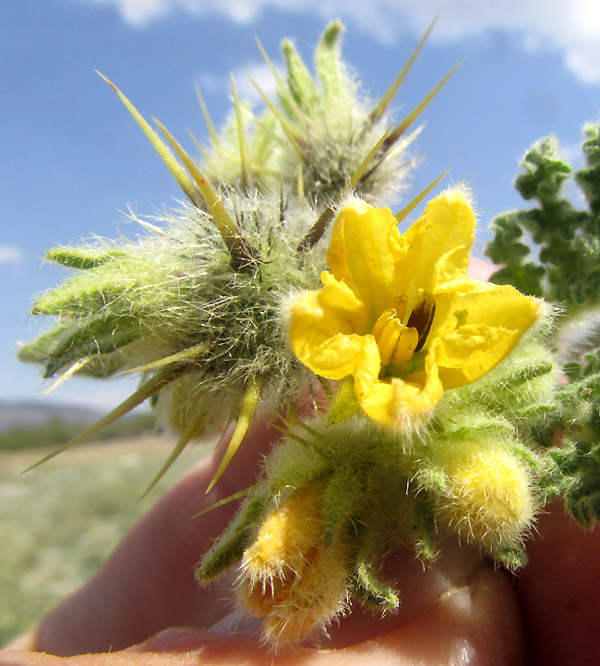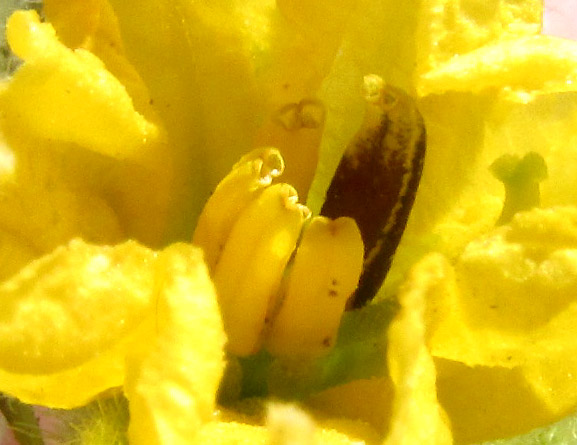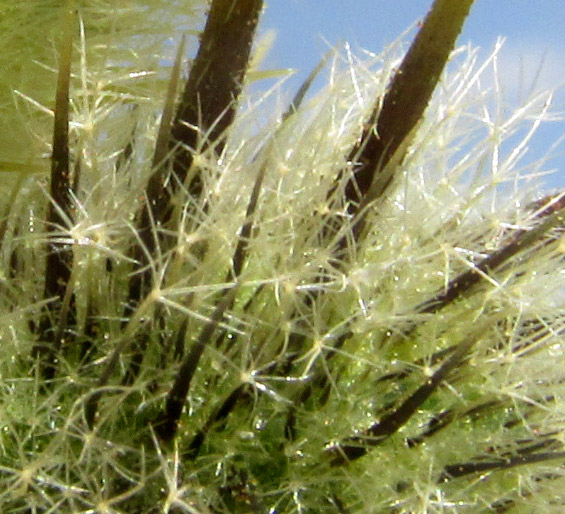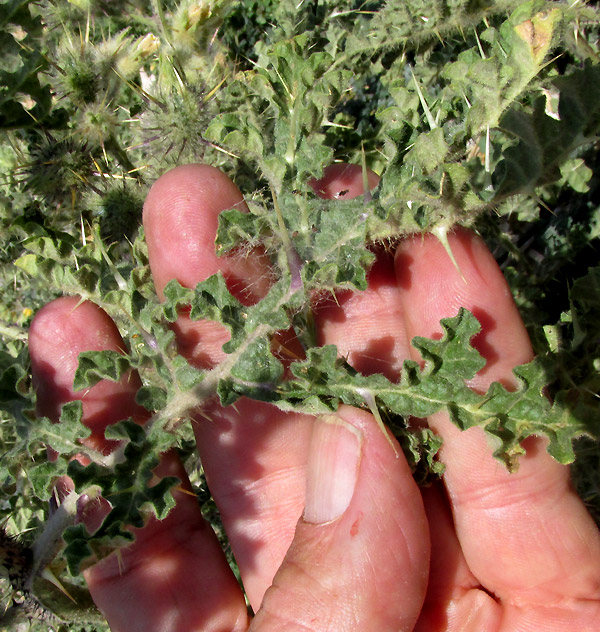Excerpts from Jim Conrad's
Naturalist Newsletter
entry dated April 28, 2023, issued from near Tequisquiapan, elevation about 1,900m (6200 ft), Querétaro state, MÉXICO
(~N20.55°, ~W99.89°)
SOLANUM TECTUM, AND ITS NAME

Now at the end of an especially rainless dry season, after last year's rainy season never developed normally, Tequisquiapan's large reservoir is completely dry, except for a narrow stream running through it, looking suspiciously like sudsy sewage. Nowadays the reservoir's flat, dry bed, normally submerged most or all of normal years, is partially vegetated with weeds. It's interesting to see which species invade such a sun-drenched, windy place. The densely hairy, heavily spiny inflorescence of one species, forming a solid, knee-high thicket over maybe 0.4 hectare (an acre) -- is shown above.
The plant's size, spininess, yellow flower color and the five stamens with one stamen different from the others reminded me of the abundant, very widespread Buffalo Bur, Solanum rostratum, but our reservoir plants bore longer spines, were much hairier, and the flowers were smaller. Also, the odd stamen's anther wasn't long and slender like that of the Buffalo Bur.

As seen above, the odd stamens in these flowers were short, thick and blackish, like overripe bananas. However, you can see that the anthers release their pollen through pores at their tips, not by slits along the sides, and that's how the genus Solanum does it, the nightshade genus.

Above, you see that the flowers were somewhat inconspicuous amid all their white-woolly herbage. I had to search awhile to find a plant with a corolla open enough to see the stamens. The above picture was taken at about noon, and there on the reservoir's dried-up floor it was hot and windy. Probably earlier that morning the blossoms had been less wilted. The hairs deserve a closer look:

Those are spectacular "stellate hairs" among spines on a blossom's calyx. Slender branches radiate from atop hair stalks which are very tall relative to other species' branched hairs. Branched hairs also occur on the herbage, and I couldn't see glands among them.

No plant yet bore mature fruits; the above were the most mature I could find. The capsules are similar to Buffalo Bur's, but with longer spines and more densely covered with long hairs.

Like Buffalo Bur, the leaves were deeply lobed, though maybe larger, and bearing longer spines.

The stems' spines were longer and their bases much thicker, too. Also, on some stems the spines were purple, like the lower ones seen above, even sometimes the purpleness extending onto stems, making purple stems. Here's what a plant looked like when not entangled with its neighbors:

And here's part of the population in its habitat, right beside the dam forming Tequisquiapan's reservoir when it rains:

The genus Solanum is big, diverse, and controversial. Depending on the expert, today it's regarded as containing roughly 1500 to 2300 species, among which are the nightshades, the spiny horse-nettles, tomato, potato, eggplant and tobacco. The genus is best represented by diverse species in western tropical America -- our area -- so sometimes we have so many species that it's hard to say which species is at hand. Still, our reservoir Solanum displays so many distinctive features that it was fairly easy to identify.
In our semiarid, upland, central Mexico region, if you have a herbaceous, spiny Solanum with compound leaves -- divided into separate leaflets -- yellow flowers, and the corolla is more than 2cm wide (5/8 inch), you have the abundant weed Buffalo Bur. However, you have a plant with all the above features, but with a corolla less than 2cm wide, like ours, you have Solanum tectum.
Solanum tectum bears no English name because it's endemic just to higher elevations in central Mexico, from the states of Durango and Jalisco south to about Mexico City. The Mexican government's CONABIO page for the species describes it as an annual weed in somewhat salty soil. Above we saw an isolated plant in soil that was coagulated and whitish the way salty soils often are, though the reservoir's water always seems a bit eutrophic, probably because of agricultural fertilizer runoff, so any salts there may not be table salt, NaCl.
Despite the species' limited occurrence, its name, Solanum tectum, is a matter of hot debate. In fact, all the published literature I find on the species refers to our plant as Solanum fructu-tecto. However, in 2021, Mark Garland published a work entitled "Is Solanum fructu-tecto validly published? Article 23 and epithets in the ablative case," in which he convincingly makes the point that the name is invalid. Garland's reason is that "Both botanical tradition and codes of nomenclature have held that specific epithets that are Latin phrases in the ablative case are unacceptable." And the Latin Solanum fructu-tecto is in the ablative case.
Wikipedia's Ablative Case page tells us that the ablative case "... is a grammatical case for nouns, pronouns, and adjectives in the grammars of various languages; it is sometimes used to express motion away from something, among other uses."
At this writing Kew's Plants of the World database recognizes Solanum tectum as the correct name. However, the GBIF database has one page claiming that Solanum tectum is correct, while another page claims that Solanum fructu-tecto is right.
In the literature I find no uses or admirable facts relating to our obscure but distinctive plant. It seems that all the fame people grant it is for the hard time its name has given to botanists.